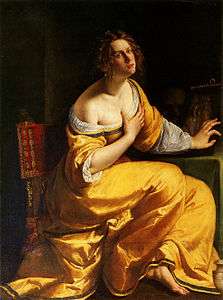Artemisia Gentileschi
Artemisia Lomi or Artemisia Gentileschi (US: /ˌdʒɛntɪˈlɛski, -tiːˈ-/,[1][2] Italian: [arteˈmiːzja dʒentiˈleski]; July 8, 1593 – c. 1656) was an Italian Baroque painter, now considered one of the most accomplished seventeenth-century artists working in the dramatic style of Caravaggio. In an era when women had few opportunities to pursue artistic training or work as professional artists, Artemisia was the first woman to become a member of the Accademia di Arte del Disegno in Florence and had an international clientele.[3][4]
_-_Artemisia_Gentileschi.jpg)
Artemisia specialized in scenes of female heroines and stories centered on women from myths, allegories, and the Bible, including victims, suicides, and warriors.[5] Some of her best known subjects are Susanna and the Elders (particularly the 1610 version in Pommersfelden), Judith Slaying Holofernes (her 1614–1620 version is in the Uffizi gallery) and Judith and Her Maidservant (her version of 1625 at the Detroit Institute of Arts).
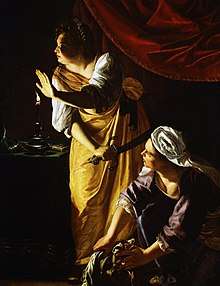
Artemisia was known for being able to depict the female figure with great naturalism[6][7] and for her skill in handling color to express dimension and drama.[8][9]
The story of her rape by Agostino Tassi as a young woman and her participation in the trial of her rapist long overshadowed her achievements as an artist.[10] For many years, she was regarded as a curiosity. Her life and art have been reexamined by scholars in the 20th century, and she is now regarded as one of the most progressive and expressive painters of her generation.
An exhibition dedicated to her work was due to be held at the National Gallery in London in 2020, but was postponed because of the coronavirus pandemic.[11]
Biography
%2C_Artemisia_Gentileschi.jpg)
Early life
Artemisia Gentileschi was born Artemisia Gentileschi Lomi in Rome on July 8, 1593, although her birth certificate from the Archivio di Stato indicated she was born in 1590, the eldest child of the Tuscan painter Orazio Gentileschi and Prudenzia di Ottaviano Montoni.[12] Artemisia was introduced to painting in her father's workshop, showing much more enthusiasm and talent than her brothers, who worked alongside her. She learned drawing, how to mix colour, and how to paint. "By 1612, when she was not yet nineteen years old, her father could boast of her exemplary talents, claiming that in the profession of painting, which she had practised for three years, she had no peer".[13]
Since her father's style took inspiration from Caravaggio during that period, her style was also heavily influenced by him. Artemisia's approach to subject matter was different from her father's. Her paintings are highly naturalistic and Orazio's are idealized. At the same time, Artemisia had to resist the "traditional attitude and psychological submission to this brainwashing and jealousy of her obvious talent".[14] By doing so, she gained great respect and recognition for her work.[15]
The first surviving work of the seventeen-year-old Artemisia was the Susanna and the Elders (1610, Schönborn collection in Pommersfelden). At the time some, influenced by the prevailing misconceptions, suspected that she was helped by her father. The painting shows how Artemisia assimilated the realism of Caravaggio without being indifferent to the language of Annibale Carracci and the Bologna school. It is one of the few paintings on the theme of Susanna showing the sexual accosting by the two Elders as a traumatic event.
Rape by Agostino Tassi
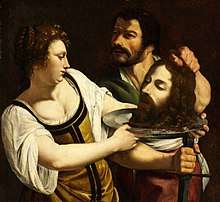
In 1611, her father was working with Agostino Tassi to decorate the vaults of Casino delle Muse inside the Palazzo Pallavicini-Rospigliosi in Rome, so Orazio hired the painter to tutor his daughter privately. During this tutelage, Tassi raped Artemisia.[16][17] Another man, Cosimo Quorli, was also involved.[18]
After the rape, Artemisia continued to have sexual relations with Tassi, with the expectation that they were going to be married in order to restore her dignity and secure her future. Tassi reneged on his promise to marry Artemisia. Nine months after the rape, when he learnt that Artemisia and Tassi were not going to be married, her father Orazio pressed charges against Tassi.[19] Orazio also claimed that Tassi stole a painting of Judith from the Gentileschi household. The major issue of this trial was the fact that Tassi had taken Artemisia's virginity. If Artemisia had not been a virgin before Tassi raped her, the Gentileschis would not have been able to press charges. During the ensuing seven-month trial, it was discovered that Tassi had planned to murder his wife, had engaged in adultery with his sister-in-law, and planned to steal some of Orazio's paintings. At the end of the trial Tassi was exiled from Rome, although the sentence was never carried out.[20] Artemisia was tortured with thumbscrews at the trial, with the intention of verifying her testimony.[21]
Artemisia was surrounded mainly by males since the loss of her mother at age 12. When Artemisia was 17, Orazio rented the upstairs apartment of their home to a female tenant, Tuzia. Artemisia befriended Tuzia; however, Tuzia allowed Agostino Tassi and Cosimo Quorlis to accompany Artemisia in Artemisia's home on multiple occasions. The day the rape occurred, Artemisia cried for the help of Tuzia, but Tuzia simply ignored Artemisia and pretended she knew nothing of what happened. Artemisia felt betrayed by Tuzia, and Tuzia's role in facilitating the rape has been compared to the role of a procuress who is complicit in the sexual exploitation of a prostitute.[22]
The painting called Mother and Child is attributed to those early years. The baby has been interpreted as an indirect reference to Agostino Tassi, her rapist, as it dates to 1612, just two years after the rape. The painting appeared in a Swedish private collection during the 1960s. It depicts a strong and suffering woman and casts light on her anguish and expressive artistic capability.[23][24]
Florentine period (1614–1620)
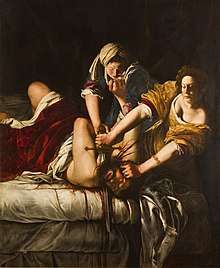
A month after the trial, Orazio arranged for his daughter to marry Pierantonio Stiattesi, a modest artist from Florence. Shortly afterward the couple moved to Florence, where Artemisia received a commission for a painting at Casa Buonarroti. She became a successful court painter, enjoying the patronage of the House of Medici and Charles I of England. It has been proposed that during this period Artemisia also painted the Virgin and Child, now in the Palazzo Spada, Rome.
While in Florence, Artemisia and Pierantonio had a daughter around 1618, Prudentia, but who was also known as Palmira, which has led some scholars to conclude erroneously that Artemisia had two children, not one.[25] Prudentia was named after Artemisia's mother, who died when Artemisia was 12. It is known that her daughter was a painter, trained by her mother, although nothing is known of her work.[26]
In Florence, Artemisia appears to have enjoyed significant success. She was the first woman accepted into the Accademia delle Arti del Disegno (Academy of the Arts of Drawing). She maintained good relations with the most respected artists of her time, such as Cristofano Allori, and was able to garner the favors and the protection of influential people, beginning with Cosimo II de' Medici, Grand Duke of Tuscany and especially of the Grand Duchess, Christina of Lorraine. Her acquaintance with Galileo Galilei, evident from a letter she wrote to the scientist in 1635, appears to stem from her Florentine years.
She was esteemed by Michelangelo Buonarroti the Younger (nephew of Michelangelo): busy with construction of Casa Buonarroti to celebrate his notable relative, he asked Artemisia—along with other Florentine artists, including Agostino Ciampelli, Sigismondo Coccapani, Giovan Battista Guidoni, and Zanobi Rosi—to contribute a painting for the ceiling. Each artist was commissioned to present an allegory of a virtue associated with Michelangelo, and Artemisia was assigned the Allegory of Inclination, presented in the form of a nude young woman holding a compass. It is believed that the subject bears a resemblance to Artemisia. Indeed, in several of her paintings, Artemisia's energetic heroines resemble her self-portraits.
In 2011, Francesco Solinas discovered a collection of thirty-six letters, dating from about 1616 to 1620, that provide new insight into Gentileschi's personal and financial life in Florence.[27] Most unexpectedly, they show that she had a passionate love affair with a wealthy Florentine nobleman named Francesco Maria Maringhi. Her husband, Stiattesi, was well aware of their relationship, and maintained a correspondence with Maringhi on the back of Artemisia's love letters. Nevertheless, he tolerated it, presumably because Maringhi was a powerful ally who provided the couple financial support. However, by 1620, rumors of the affair had begun to spread in the Florentine court, and this fact, combined with ongoing legal and financial problems, led them to resettle in Rome.
Significant works from this period include La Conversione della Maddalena (The Conversion of the Magdalene), Self-Portrait as a Lute Player (in the collection of the Wadsworth Atheneum Museum of Art) and Giuditta con la sua ancella (Judith and her Maidservant), now in the Palazzo Pitti. Artemisia painted a second version of Judith beheading Holofernes, which now is housed in the Uffizi Gallery of Florence. The first, smaller Judith Beheading Holofernes (1612–13) is displayed in the Museo di Capodimonte, Naples. Despite her success, financial excesses borne by her for her husband led to problems with creditors, and she fell out with her husband. She returned without him to Rome in 1621.
Return to Rome, Venetian period (1621–1630)
Artemisia arrived in Rome the same year her father Orazio departed for Genoa. While there is not enough evidence for this, some believe that Artemisia followed her father to Genoa, asserting that this time together would have accentuated the similarity of their styles, making it often difficult to determine which of the two painted certain works. Most of the evidence, however, supports the notion that Artemisia remained in Rome, trying to find a home and raise her daughter.
Caravaggio's style remained highly influential and converted many painters to following his style (the so-called Caravaggisti), such as Carlo Saraceni (who returned to Venice 1620), Bartolomeo Manfredi, and Simon Vouet. She and Vouet would go on to have a professional relationship and would influence each other in terms of style and their learnings from Caravaggio's style.[28] Painting styles in Rome during the early seventeenth century were diverse, however, demonstrating a more classic manner of the Bolognese disciples of the Carracci and the baroque style of Pietro da Cortona.
It appears that Artemisia also was associated with the Academy of the Desiosi. She was celebrated with a portrait carrying the inscription "Pincturare miraculum invidendum facilius quam imitandum" (To paint a wonder is more easily envied than imitated). During the same period she became associated with Cassiano dal Pozzo, a humanist and a collector and lover of arts, while the visiting French artist Pierre Dumonstier II produced a black and red chalk drawing of her right hand in 1625.[29]
Despite her artistic reputation, her strong personality, and her numerous good relationships, however, Rome was not so lucrative as she hoped. Her style, tone of defiance, and strength relaxed. She painted less intense works; for instance, her second version of Susanna and the Elders (1622).[30] The appreciation of her art was narrowed down to portraits and to her ability with biblical heroines. She did not receive any of the lucrative commissions for altarpieces. The absence of sufficient documentation makes it difficult to follow Artemisia's movements in this period. It is certain that between 1627 and as late as 1630, she moved to Venice, perhaps in search of richer commissions. Evidence for this is that verses and letters were composed in appreciation of her and her works in Venice.
Although it is sometimes difficult to date her paintings, it is possible to assign certain works by her to these years, the Portrait of a Gonfaloniere, today in Bologna (a rare example of her capacity as portrait painter) and the Judith and her Maidservant today in the Detroit Institute of Arts. The Detroit painting is notable for her mastery of chiaroscuro and tenebrism (the effects of extreme lights and darks), techniques for which Gerrit van Honthorst, Trophime Bigot, and many others in Rome were famous. Her The Sleeping Venus, today in the Virginia Museum of Fine Arts, Richmond, and her Esther and Ahasuerus now in the Metropolitan Museum of Art in New York, are testimony to her assimilation of the lessons of Venetian luminism.
Naples and the English period (1630–1654)
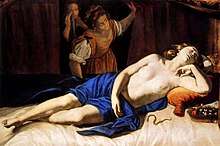
In 1630, Artemisia moved to Naples, a city rich with workshops and art lovers, in search of new and more lucrative job opportunities. The 18th-century biographer Bernardo de' Dominici speculated that Artemisia was already known in Naples before her arrival.[31] She may have been invited to Naples by the Duke of Alcalá, Fernando Enriquez Afan de Ribera, who had three of her paintings: a Penitent Magdalene, Christ Blessing the Children, and David with a Harp.[32] Many other artists, including Caravaggio, Annibale Carracci, and Simon Vouet, had stayed in Naples for some time in their lives. At that time, Jusepe de Ribera, Massimo Stanzione, and Domenichino were working there, and later, Giovanni Lanfranco and many others would flock to the city. The Neapolitan debut of Artemisia is represented by the Annunciation in the Capodimonte Museum.[32] She remained in Naples for the remainder of her career, with the exceptions of a brief trip to London and some other journeys.
On Saturday, March 18, 1634, the traveller Bullen Reymes records in his diary visiting Artemisia and Palmira ('who also paints') with a group of fellow-Englishmen.[33] She had relations with many renowned artists, among them Massimo Stanzione, with whom, Bernardo de' Dominici reports, she started an artistic collaboration based on a real friendship and artistic similarities. Artemisia's work influenced Stanzione's use of colors as seen in his Assumption of the Virgin, c. 1630. De' Dominici states that "Stanzione learned how to compose an istoria from Domenichino, but learned his coloring from Artemisia".[31]
In Naples for the first time Artemisia started working on paintings in a cathedral, dedicated to San Gennaro nell'anfiteatro di Pozzuoli (Saint Januarius in the amphitheater of Pozzuoli) in Pozzuoli. During her first Neapolitan period she painted the Birth of Saint John the Baptist now in the Prado in Madrid, and Corisca e il satiro (Corisca and the satyr), in a private collection. In these paintings Artemisia again demonstrates her ability to adapt to the novelties of the period and handle different subjects, instead of the usual Judith, Susanna, Bathsheba, and Penitent Magdalenes, for which she already was known. Many of these paintings were collaborations; Bathsheba, for instance, was attributed to Artemisia, Codazzi, and Gargiulo.[32]
In 1638, Artemisia joined her father in London at the court of Charles I of England, where Orazio became court painter and received the important job of decorating a ceiling allegory of Triumph of Peace and the Arts in the Queen's House, Greenwich built for Queen Henrietta Maria. Father and daughter were working together once again, although helping her father probably was not her only reason for travelling to London: Charles I had invited her to his court, and it was not possible to refuse. Charles I was an enthusiastic collector, willing to incur criticism for his spending on art. The fame of Artemisia probably intrigued him, and it is not a coincidence that his collection included a painting of great suggestion, the Self-Portrait as the Allegory of Painting, which is the lead image of this article.
Orazio died suddenly in 1639. Artemisia had her own commissions to fulfill after her father's death, although there are no known works assignable with certainty to this period. It is known that Artemisia had already left England by 1642, when the English Civil War was just starting. Nothing much is known about her subsequent movements. Historians know that in 1649 she was in Naples again, corresponding with Don Antonio Ruffo of Sicily, who became her mentor during this second Neapolitan period. The last known letter to her mentor is dated 1650 and makes clear that she still was fully active.
As Artemisia grew older, her work became more graceful and "feminine," and while this was to some extent part of the general shift in taste and sensibility, it must also have resulted from the artist becoming more and more self-consciously a female painter.[34]
Artemisia was once believed to have died in 1652/1653;[5] however, modern evidence has shown that she was still accepting commissions in 1654, although she was increasingly dependent upon her assistant, Onofrio Palumbo.[35]
Some have speculated that she died in the devastating plague that swept Naples in 1656 and virtually wiped out an entire generation of Neapolitan artists.
Some works in this period are the Susanna and the Elders today in Brno, the Virgin and Child with a Rosary today in El Escorial, the David and Bathsheba today in Columbus, Ohio, and the Bathsheba today in Leipzig.
Her 'David with the Head of Goliath', rediscovered in London in 2020, has been attributed by art historian Gianni Papi to Artemisia's London period, in an article published in The Burlington Magazine[36][37][38][39][40]
Artistic importance

The research paper "Gentileschi, padre e figlia" (1916) by Roberto Longhi, an Italian critic, described Artemisia as "the only woman in Italy who ever knew about painting, coloring, drawing, and other fundamentals". Longhi also wrote of Judith Slaying Holofernes: "There are about fifty-seven works by Artemisia Gentileschi and 94% (forty-nine works) feature women as protagonists or equal to men".[41] These include her works of Jael and Sisera, Judith and her Maidservant, and Esther. These characters intentionally lacked the stereotypical "feminine" traits—sensitivity, timidness, and weakness—and were courageous, rebellious, and powerful personalities;[42] such subjects are now grouped as the Power of Women. A nineteenth-century critic commented on Artemisia's Magdalene stating, "no one would have imagined that it was the work of a woman. The brush work was bold and certain, and there was no sign of timidness".[41] In Ward Bissell's view, she was well aware of how women and female artists were viewed by men, explaining why her works in the beginning of her career were so bold and defiant.[14]
Longhi wrote: "Who could think in fact that over a sheet so candid, a so brutal and terrible massacre could happen [...] but—it's natural to say—this is a terrible woman! A woman painted all this? ... there's nothing sadistic here, instead what strikes the most is the impassibility of the painter, who was even able to notice how the blood, spurting with violence, can decorate with two drops the central spurt! Incredible I tell you! And also please give Mrs. Schiattesi—the conjugal name of Artemisia—the chance to choose the hilt of the sword! At last don't you think that the only aim of Giuditta is to move away to avoid the blood which could stain her dress? We think anyway that that is a dress of Casa Gentileschi, the finest wardrobe in the Europe during 1600, after Van Dyck."[43][44]
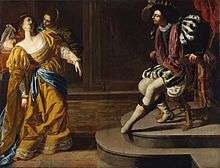
Feminist studies increased the interest in Artemisia Gentileschi, underlining her rape and subsequent mistreatment, and the expressive strength of her paintings of biblical heroines, in which the women are interpreted as willing to manifest their rebellion against their condition. In a research paper from the catalogue of the exhibition "Orazio e Artemisia Gentileschi", which took place in Rome in 2001 (and after in New York), Judith W. Mann critiques feminist opinion of Artemisia, finding that old stereotypes of Artemisia as sexually immoral have been replaced by new stereotypes established in feminist readings of Artemisia's paintings:
- Without denying that sex and gender can offer valid interpretive strategies for the investigation of Artemisia's art, we may wonder whether the application of gendered readings has created too narrow an expectation. Underpinning Garrard's monograph, and reiterated in a limited way by R. Ward Bissell in his catalogue raisonné, are certain presumptions: that Artemisia's full creative power emerged only in the depiction of strong, assertive women, that she would not engage in conventional religious imagery such as the Madonna and Child or a Virgin who responds with submission to the Annunciation, and that she refused to yield her personal interpretation to suit the tastes of her presumable male clientele. This stereotype has had the doubly restricting effect of causing scholars to question the attribution of pictures that do not conform to the model, and to value less highly those that do not fit the mold.[45]
Because Artemisia returned again and again to violent subject matter such as Judith and Holofernes, a repressed-vengeance theory has been postulated.[46] Some art historians suggest, however, that she was shrewdly taking advantage of her fame from the rape trial to cater to a niche market in sexually charged, female-dominant art for male patrons.[47]
The most recent critics, starting from the difficult reconstruction of the entire catalogue of the Gentileschi, tried to give a less reductive reading of the career of Artemisia, placing it more accurately in the context of the different artistic environments in which the painter actively participated. A reading such as this restores Artemisia as an artist who fought with determination—using the weapon of personality and of the artistic qualities—against the prejudices expressed against women painters; being able to introduce herself productively in the circle of the most respected painters of her time, embracing a series of pictorial genres that probably were more ample and varied than her paintings suggest.[46]
Feminist perspectives
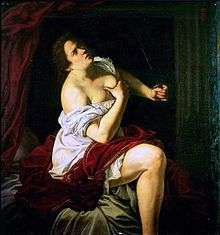
Feminist interest in Artemisia Gentileschi dates from the 1970s when the feminist art historian Linda Nochlin published an article titled "Why Have There Been No Great Women Artists?" in which that question was dissected and analyzed. The article explored the definition of "great artists" and posited that oppressive institutions, not lack of talent, have prevented women from achieving the same level of recognition that men received in art and other fields. Nochlin said that studies on Artemisia and other female artists were "worth the effort" in "adding to our knowledge of women's achievement and of art history generally."[48] According to the foreword by Douglas Druick in Eve Straussman-Pflanzer's Violence & Virtue: Artemisia's Judith Slaying Holofernes, Nochlin's article prompted scholars to make more of an attempt to "integrate women artists into the history of art and culture."[49]
Artemisia and her oeuvre became a focus again, having had little attention in art history scholarship save Roberto Longhi's article "Gentileschi padre e figlia (Gentileschi, father and daughter)" in 1916 and R. Ward Bissell's article "Artemisia Gentileschi—A New Documented Chronology" in 1968. As Artemisia and her work began to garner new attention among feminists and art historians, more literature about her, fictional and biographical, was published. A fictional account of her life by Anna Banti, wife of critic Roberto Longhi, was published in 1947. This account was received well by literary critics but was criticized by feminists, notably Laura Benedetti, for being lenient in historical accuracy in order to draw parallels between author and artist.[50] The first full, factual account of Artemisia's life, The Image of the Female Hero in Italian Baroque Art, was published in 1989 by Mary Garrard, a feminist art historian. She then published a second, smaller book titled Artemisia Gentileschi around 1622: The Shaping and Reshaping of an Artistic Identity in 2001 which explored the artist's work and identity. Garrard noted that analysis of Artemisia's oeuvre lacks focus and stable categorization outside of "woman", though Garrard questions whether femaleness is a legitimate category by which to judge her art at all.[51]
Artemisia is known for her portrayals of subjects from the Power of Women group, for example her versions of Judith Slaying Holofernes. She is also known for the rape trial in which she was involved, which scholar Griselda Pollock has argued had unfortunately become the repeated "axis of interpretation of the artist's work". Gentileschi's status in popular culture, though she is much admired by among art historians, is deemed by Pollock to be less due to her work and more to the sensationalism caused by the persistent focus on the rape trial during which she was tortured. Pollock offers a counter reading of the artist's dramatic narrative paintings, refusing to see the Judith and Holofernes images as responses to rape and the trial. Instead, Pollock points out that the subject of Judith and Holoferenes is not a revenge theme, but a story of political courage and indeed collaboration by two women committing a daring political murder in a war situation. Pollock seeks to shift attention from sensationalism towards deeper analysis of Gentileschi's paintings, notably of death and loss, suggesting the significance of her childhood bereavement as a source of her singular images of the dying Cleopatra. Pollock also argues that Gentileschi's success in the seventeenth century depended on her producing paintings for patrons often portraying subjects they selected. She aims to place Gentileschi's career in its historical context of taste for dramatic narratives of heroines from the Bible or classical sources.[52] In a more negative vein, American professor Camille Paglia has argued that modern feminist preoccupation with Artemisia is misguided and that her accomplishments have been overstated: "Artemisia Gentileschi was simply a polished, competent painter in a Baroque style created by men."[53] Feminist literature tends to revolve around the event of Artemisia's rape, largely portraying her as a traumatized but noble survivor whose work became characterized by sex and violence as a result of her experience. Pollock (2006) interpreted the film by Agnès Merlet as a typical example of the inability of popular culture to look at the painter's remarkable career over many decades and in many major centres of art rather than this one episode. A literature review by Laura Benedetti, "Reconstructing Artemisia: Twentieth Century Images of a Woman Artist", concluded that Artemisia's work is often interpreted according to the contemporary issues and personal biases of the authors. Feminist scholars, for example, have elevated Artemisia to the status of feminist icon, which Benedetti attributed to Artemisia's paintings of formidable women and her success as an artist in a male-dominated field while also being a single mother.[50] Elena Ciletti, author of Gran Macchina a Bellezza, wrote that "The stakes are very high in Artemisia's case, especially for feminists, because we have invested in her so much of our quest for justice for women, historically and currently, intellectually and politically."[54]
Feminist scholars suggest that Gentileschi wanted to take a stand against the stereotype of female submissiveness. One example of this symbolism appears in Gentileschi's "Corsica and The Satyr," created between 1630 and 1635. In the painting, a nymph runs away from a satyr. The satyr attempts to grab the nymph by her hair, but the hair is in fact a wig. Here, Gentileschi depicts the nymph to be quite clever and to be actively resisting the aggressive attack of the satyr.
Contemporary female painters
For a woman at the beginning of the seventeenth century, Artemisia being a painter represented an uncommon and difficult choice, but not an exceptional one. Scholars have argued that Artemisia was at least partially aware of "her position as a female artist and the current representations of women's relationship to art."[55] This is evident in her allegorical self portrait, Self Portrait as La Pittura, which shows Artemisia as a muse, "symbolic embodiment of the art" and as a professional artist.[55] Before Artemisia, between the end of the 1500 and the beginning of 1600, other women painters had successful careers, including Sofonisba Anguissola (born in Cremona around 1530). Later Fede Galizia (born in Milano or Trento in 1578) painted still lifes and a Judith with the Head of Holofernes.
Italian Baroque painter Elisabetta Sirani was another female artist from this same time period. Sirani's painting "Allergory Painting of Clio" shares a common color scheme with Artemisia's work. Elisabetta was popular for a brief period of time, but she was recognized.
Other women painters also began their careers while Artemisia was alive. Judged on their artistic merits, Longhi's statement that Artemisia was "the only woman in Italy who ever knew about painting" is clearly false. There is no doubt that Artemisia continues to be among the most highly regarded of women artists, and she has attained her place among the great Baroque artists.
In popular culture
The first writer who produced a novel around the figure of Artemisia may have been George Eliot in Romola (1862–63), where some aspects of Gentileschi's story, while set in Florence in Gentileschi's time, are recognizable, but much embroidered. A later and clearer use of Gentileschi's story appears in Anna Banti's Artemisia. Banti's book is written in an "open diary" format, in which she maintains a dialogue with Artemisia.
Gentileschi is one of the women represented in The Dinner Party, an installation artwork by Judy Chicago that was first exhibited in 1979.
Artemisia, and more specifically her painting Judith Beheading Holofernes, are referred to in Wendy Wasserstein's play The Heidi Chronicles (1988), in which the main character, Heidi, lectures about it as part of her art history course on female painters. At the end of the play, Heidi adopts a daughter she names Judy, which is at least a partial reference to the painting.
Canadian playwright Sally Clark wrote several stage plays based on the events leading up to and following the rape of Artemisia. Life Without Instruction, commissioned by Nightwood Theatre in 1988, premiered at Theatre Plus Toronto on August 2, 1991.
Gentileschi's life and the Judith Slaying Holofernes painting played a pivotal role in the miniseries Painted Lady (1997), starring Helen Mirren.[56]
The film Artemisia (1997), by Agnès Merlet, tells the story of Artemisia's entry into being a professional artist, her relationship with Tassi, and the trial. Merlet exonerates Tassi of rape, not only by depicting their sex as loving and consensual (which was controversial when the film was released), but also by two ahistorical fabrications: Artemisia denies the rape under torture, while Tassi falsely confesses to rape to stop Artemisia's torment.
Susan Vreeland published The Passion of Artemisia (2002), a biographical novel based on her life.[56]
She appears in Eric Flint's Ring of Fire alternate history, being mentioned in 1634: The Galileo Affair (2004) and figuring prominently in 1635: The Dreeson Incident (2008), as well as appearing in a number of shorter stories in the 1632 universe.
The novel Maestra (2016) by L.S. Hilton includes Artemisia as a central reference for the main character, and several of her paintings are discussed.
The novel Salem's Cipher (2016) by Jess Lourey used the painting Judith Beheading Holofernes to send a clue.
Blood Water Paint, a play by Joy McCullough, was turned into the novel Blood Water Paint (2017) by the same author. Productions of the play were performed in Seattle in 2015 and 2019.[57][58][59]
An episode of the British TV crime series Endeavour (2018) depicts a series of murders inspired by Gentileschi's biblical paintings of women taking vengeance on the men who harmed or abused them.[56]
Breach Theatre's It's True, It's True, It's True (2018) is a play derived from the transcripts of the trial, translated from Latin and Italian into conversational English, and was first performed at the Edinburgh Fringe Festival, where it won The Stage Edinburgh award and a Fringe First award.[60] After touring the UK, it was then broadcast on BBC Four on 9 February 2020 and was available on BBC iPlayer until 11 March 2020.[61]
The speculative nonfiction opera titled Artemisia by Laura Schwendinger was performed in San Francisco in 2019.[62]
Selected works
 The Virgin nursing the Child, c. 1616–1618
The Virgin nursing the Child, c. 1616–1618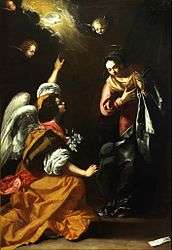 Annunciation, 1630, Museo di Capodimonte
Annunciation, 1630, Museo di Capodimonte Bathsheba, c. 1645–1650, Neues Palais, Potsdam
Bathsheba, c. 1645–1650, Neues Palais, Potsdam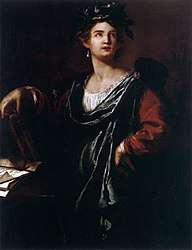 Clio: the Muse of History, 1632, Palazzo Blu
Clio: the Muse of History, 1632, Palazzo Blu David and Bathsheba, c. 1636–1637, Columbus Museum of Art
David and Bathsheba, c. 1636–1637, Columbus Museum of Art St Cecilia Playing a Lute, c. 1616, Galleria Spada
St Cecilia Playing a Lute, c. 1616, Galleria Spada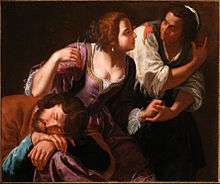
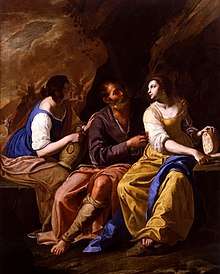 Lot and Daughters of Lot, 1635–1638, Toledo Museum of Art
Lot and Daughters of Lot, 1635–1638, Toledo Museum of Art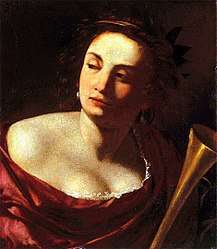 Allegory of Fame, c. 1630–1635
Allegory of Fame, c. 1630–1635
See also
- List of works by Artemisia Gentileschi
- Plautilla Nelli, who paved the way for women painters 50 years earlier
References
Citations
- "Gentileschi". The American Heritage Dictionary of the English Language (5th ed.). Boston: Houghton Mifflin Harcourt. Retrieved May 31, 2019.
- "Gentileschi". Merriam-Webster Dictionary. Retrieved May 31, 2019.
- Gunnell, Barbara (July 4, 1993), "The rape of Artemisia", The Independent, archived from the original on 28 December 2014, retrieved December 28, 2014
- Bissell, R. Ward. Artemisia Gentileschi and the Authority of Art Critical Reading and Catalogue Raisonné. University Park: Pennsylvania State University Press, 1999.
- Lubbock, Tom (September 30, 2005), "Great Works: Judith and her Maidservant", The Independent, London, p. 30, Review section, archived from the original on May 2, 2015
- Patrizia Cavazzini, "Artemisia in Her Father's House", in Orazio and Artemisia Gentileschi (New Haven and London, 2001), pp. 283–95.
- Mary D. Garrard, "Artemisia Gentileschi's Self Portrait as the Allegory of Painting", The Art Bulletin, Vol. 62, No.1 (Mar.,1980) pp. 97–112.
- Adelina Modesti, "'Il Pennello Virile': Elisabetta Sirani and Artemisia Gentileschi as Masculinized Painters?" in Artemisia Gentileschi in a Changing Light, ed. Shelia Barker (Turnhout, 2018)
- Jesse Locker, "Artemisia in the Eyes of the Neapolitan Poets," from Artemisia Gentileschi: The Language of Painting (New Haven: Yale University Press, 2015)
- Elizabeth S. Cohen, "The Trials of Artemisia Gentileschi: A Rape as History." Sixteenth Century Journal XXXI/1 (2000): 47–75
- "Artemisia | Exhibitions | National Gallery, London". www.nationalgallery.org.uk. Retrieved 2019-05-10.
- Bissell (1999), p. 135
- Garrard, Mary (1989). Artemisia Gentileschi: The Image of the Female Hero in Italian Baroque Art. Princeton, NJ: Princeton University Press. p. 13.
- Bissell (1999), p. 113
- Bissell (1999)
- Cohen, Elizabeth S. (2000-01-01). "The Trials of Artemisia Gentileschi: A Rape as History". The Sixteenth Century Journal. 31 (1): 47–75. doi:10.2307/2671289. JSTOR 2671289.
- "Artemisia Gentileschi - Biography & Art - The Art History Archive". www.arthistoryarchive.com. Retrieved 2017-01-12.
- "Artemisia, The Rape and the Trial". www.webwinds.com. Retrieved 2017-01-12.
- Cohen, Elizabeth (Spring 2000), "The Trials of Artemisia Gentileschi: A Rape as History", The Sixteenth Century Journal, 31 (1): 47–75, doi:10.2307/2671289, JSTOR 2671289
- "Artemisia Gentileschi". Biography.com. May 13, 2014. Retrieved 28 September 2017.
- Artemisia: The Rape and the Trial Webwinds.com
- Zarucchi, Jeanne Morgan (Autumn 1998 – Winter 1999). "The Gentileschi "Danaë": A Narrative of Rape". Woman's Art Journal. 19 (2): 13–19. doi:10.2307/1358400. JSTOR 1358400.
- Moss, Matthew. "Distraught young mother breastfeeds her infant. Artemisia Gentileschi 1593-1653". academia.edu.
The feeding child, his full bloated tummy attached to two chubby legs is holding on firmly to the young woman's arm while his dark somnolent eyes peer into the distance with a look of self-satisfaction. The artist shows him at the moment shortly after having been fed. In the process of drawing the milk from the mother's nipples, his sharp newly emerged teeth, bite the mother's breast, sufficiently to draw blood. That part of the shift covering her right breast, from which he has already fed, is blood soaked, causing her underlying injuries. The suffering mother's face is, turned away from the child. Her pallid features and tortured heavy-lidded eyes display the physical signs of amnesia from the loss of blood.
- "An Artemisia Conundrum". artmontecarlo.com. October 22, 2016.
- Bissell (1999), p. 159
- Garrard (1989), p. 63
- Solinas, Francesco (2011). Lettere di Artemisia: Edizione critica e annotata con quarantatre documenti inediti. Rome: De Luca. ISBN 9788865570524.
- Richard Spear, "I have made up my mind to take a short trip to Rome," in Orazio and Artemisia Gentileschi, 335–43.
- "Right hand of Artemisia Gentileschi holding a brush. 1625 Black and red chalk", British Museum, 9 October 2016, retrieved October 9, 2016
- Brigstocke, Hugh (2001), "Gentileschi, father and daughter", The Oxford Companion to Western Art (2003 ed.), Oxford University Press, ISBN 9780198662037, retrieved September 13, 2016
- Locker, Jesse (2014). Artemisia Gentileschi: The Language of Painting. Yale University Press. p. 100.
- Christiansen, Keith (2002). Orazio and Artemisia Gentileschi. New York, Metropolitan Museum of Art. p. 392.
- Chaney (2000), p. 111
- Garrard (1989), pp. 136–37
- De Vito, Giuseppe (2005). "A note on Artemisia Gentileschi and Her Collaborator Onofrio Palumbo". Burlington Magazine. 1232 (137): 749.
- Papi, Gianni; Gillespie, Simon; Chaplin, Tracey D (2020). "A 'David and Goliath' by Artemisia Gentileschi rediscovered". The Burlington Magazine. 162 (1404): 188–195. Retrieved 1 March 2020.
- Gerlis, Melanie (27 February 2020). "The Art Market". The Financial Times.
- Sanderson, David (28 February 2020). "David and Goliath painting revealed as an Artemisia Gentileschi". The Times.
- Moorhead, Joanna (28 February 2020). "Newly attributed Artemisia Gentileschi painting of David and Goliath revealed in London". The Art Newspaper.
- Moorhead, Joanna (29 February 2020). "Artemisia Gentileschi, the baroque #MeToo heroine who avenged her rape through art". The Guardian.
- Bissell (1999), p. 112
- Bissell (1999), pp. 112–113
- Longhi, Roberto (1916). "Gentileschi padre e figlia". L'Arte.
- "Orazio and Artemisia Gentileschi | MetPublications | The Metropolitan Museum of Art". www.metmuseum.org. Retrieved 2017-01-12.
- Christiansen, Keith; Mann, Judith W. (2001). Orazio and Artemisia Gentileschi. New York: The Metropolitan Museum of Art. p. 250. ISBN 1588390063. Retrieved 2017-01-12.
- Holly Williams. "The artist who triumphed over her shocking rape and torture". Retrieved 2020-04-16.
- Moss, Matthew. "Distraught young mother breastfeeds her infant. Artemisia Gentileschi 1593-1653". academia.edu.
The artist's intention was, likely, an attempt to express her feeling through the painter's medium, that of her impotence and he powerlessness in the face of a society where violence against a woman was the norm; that had the power, and had used it, to treat her with intolerance and disrespect. This, in the face of the mild six month jail sentence the courts inflicted on Agostino Tassi.
- Nochlin (1971)
- Straussman-Pflanzer (2013)
- Benedetti, Laura (Winter 1999), "Reconstructing Artemisia, Twentieth Century Images of a Woman Artist", Comparative Literature, 51 (1): 42–46, doi:10.2307/1771455, JSTOR 1771455
- Garrard (2001)
- Pollock Differencing the Canon: Routledge 1999
- Camille Paglia (1994). Vamps and Tramps NY: Vintage, p. 115
- Ciletti (2006)
- Rozsika, Parker (1981-10-29). Old mistresses : women, art, and ideology. Pollock, Griselda. London. ISBN 0710008791. OCLC 8160325.
- Jenni, Murray (October 12, 2018). "The Vengeance of Artemisia Gentileschi". Literary Hub. Retrieved October 15, 2018.
- "Blood/Water/Paint".
- "Blood Water Paint".
- https://www.penguinrandomhouse.com/books/557182/blood-water-paint-by-joy-mccullough/9780735232136/
- Snow, Georgia (2020-02-06). "Breach Theatre's It's True, It's True, It's True to be given BBC TV screening | News". The Stage. Retrieved 2020-03-10.
- Snow, Georgia (2020-02-06). "Breach Theatre's It's True, It's True, It's True to be given BBC TV screening | News". The Stage. Retrieved 2020-03-10.
- "Artemisia, an Opera By Laura Schwendinger".
Bibliography
- Bissell, R. Ward (1999), Artemisia Gentileschi and the Authority of Art: Critical Reading and Catalogue Raisonné, The Pennsylvania University Press, ISBN 0-271-02120-9
- Chaney, Edward (2000), The Evolution of the Grand Tour: Anglo-Italian Cultural Relations since the Renaissance, Routledge
- Ciletti, Elena (2006), "Gran Macchina a Bellezza", in Bal, Mieke (ed.), The Artemisia Files: Artemisia Gentileschi for Feminists and Other Thinking People, Chicago, Illinois: University of Chicago Press
- Garrard, Mary D. (1989), Artemisia Gentileschi: The Image of the Female Hero in Italian Baroque Art, Princeton University Press, ISBN 978-0-691-04050-9
- Garrard, Mary D. (2001), Artemisia Gentileschi Around 1622: The Shaping and Reshaping of an Artistic Identity, Los Angeles, California: University of California Press, ISBN 978-0520228412
- Nochlin, Linda (1971), "Why Have There Been No Great Woman Artists?", in Gornick, Vivian; Moran, Barbara K. (eds.), Woman in Sexist Society: Studies in Power and Powerlessness, Basic Books
- Pollock, Griselda (1999), Differencing the Canon: Feminist Desire and the Writing of Art's Histories, London and New York: Routledge
- Pollock, Griselda (2006), "Feminist Dilemmas with the Art/Life Problem", in Bal, Mieke (ed.), The Artemisia Files: Artemisia Gentileschi for Feminists and Other Thinking People, Chicago, Illinois: University of Chicago Press
- Straussman-Pflanzer, Eve (2013), Violence & Virtue: Artemisia Gentileschi's Judith Slaying Holofernes, Chicago, Illinois: Art Institute of Chicago
Further reading
- Barker, Sheila (December 2014). "A new document concerning Artemisia Gentileschi's marriage". The Burlington Magazine. Vol. 156 no. 1341. pp. 803–804.
- Barker, Sheila (2017). Artemisia Gentileschi in a Changing Light. Harvey Miller Publishers.
- Christiansen, Keith (2004). "Becoming Artemisia: Afterthoughts on the Gentileschi Exhibition". Metropolitan Museum Journal. 39: 101–126. doi:10.1086/met.39.40034603.
- Christiansen, Keith; Mann, Judith W. (2001). "Orazio and Artemisia Gentileschi". New Haven and London: Exh. cat., Metropolitan Museum of Art.
- Contini, Roberto; Solinas, Francesco (2011). Artemisia Gentileschi: storia di una passione (in Italian). Palazzo reale di Milano, Milano: 24 ore cultura.
- Contini, Roberto; Solinas, Francesco (2013). Artemisia: la musa Clio e gli anni napoletani (in Italian). Roma, De Luca: Blu palazzo d'arte e cultura (Pisa).
- Garrard, Mary D. (2001). Artemisia Gentileschi around 1622: The Shaping and Reshaping of an Artistic Identity. University of California Press. ISBN 978-0520228412.
- Garrard, Mary D. (1989). Artemisia Gentileschi: The Image of the Female Hero in Italian Baroque Art. Princeton University Press. ISBN 9780691002859.
- Garrard, Mary D. (2005). Reclaiming Female Agency: Feminist Art History after Postmodernism. University of Californian Press.
- Greer, Germaine (1979). The Obstacle Race: The Fortunes of Women Painters and Their Work. London: Martin Secker and Warburg.
- Lapierre, Alexandra (2001). Artemisia: The Story of a Battle for Greatness. Vintage. ISBN 0-09-928939-3.
- Locker, Jesse M. (2015). Artemisia Gentileschi: The Language of Painting. New Haven, Yale University Press. ISBN 9780300185119.
- Lutz, Dagmar (2011). Artemisia Gentileschi: Leben und Werk (in German). Belser, Stuttgart, Germany. ISBN 978-3-7630-2586-2.
- Mann, Judith (2006). Artemisia Gentileschi: Taking Stock. Brepols Publishers. ISBN 978-2503515076.
- Rabb, Theodore K. (1993). Renaissance Lives: Portraits of an Age. New York: Pantheon Books.
- Shulman, Ken (1 September 1991). "A Painter of Heroic Women In a Brawling, Violent World: Heroic Women in a Violent, Brawling World". New York Times. p. H23.
- Solinas, Francesco; Nicolaci, Michele; Primarosa, Yuri (2011). Lettere di Artemisia: edizione critica e annotata con quarantatre documenti inediti (in Italian). Roma, De Luca.
- Straussman-Pflanzer, Eve (2013). Violence & virtue: Artemisia Gentileschi's Judith slaying Holofernes. Chicago: The Art Institute of Chicago.
- Vreeland, Susan (2002). "The Passion of Artemisia". Headline Review. ISBN 0-7472-6533-X.
- Zarucchi, Jeanne Morgan (Autumn 1998 – Winter 1999). "The Gentileschi Danaë: A Narrative of Rape". Woman's Art Journal, Vol. 19, No. 2, 13–16. JSTOR 1358400. doi:10.2307/1358400.
External links
| Wikimedia Commons has media related to Artemisia Gentileschi. |
- The Life and Art of Artemisia Gentileschi
- Artemisia, The Rape and the Trial
- Paintings by Gentileschi
- Brooklyn Museum Artemisia Gentileschi
- Art History Archive Baroque Artemia Gentileschi
- "Violence and Virtue: Artemisia Gentileschi's Judith Slaying Holofernes"
- Artemisia Gentileschi Biography
- 10 Facts You May Not Know About Artemisia Gentileschi
